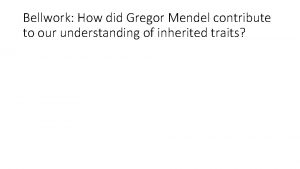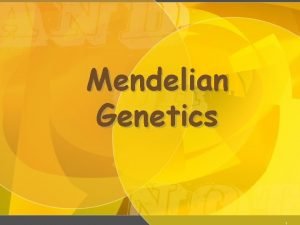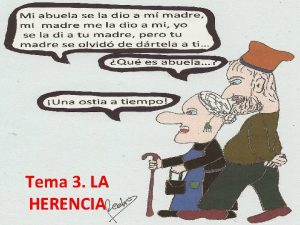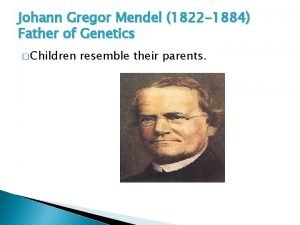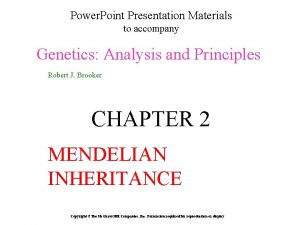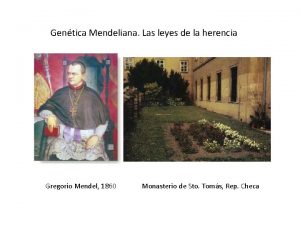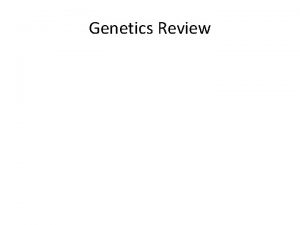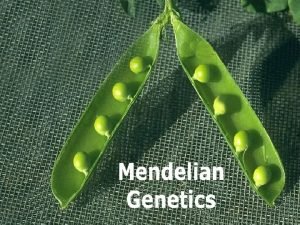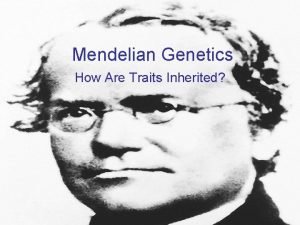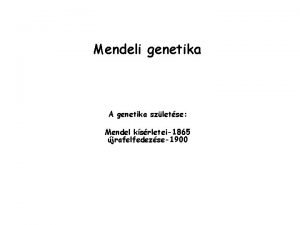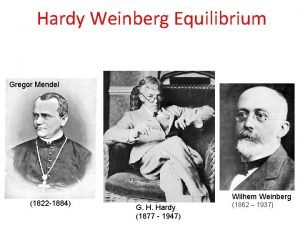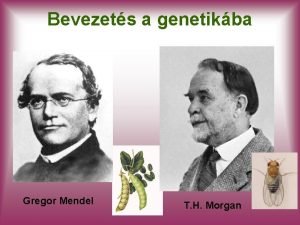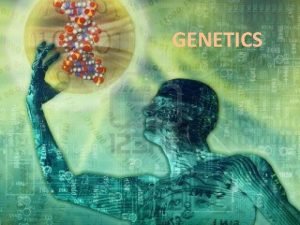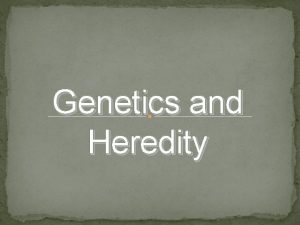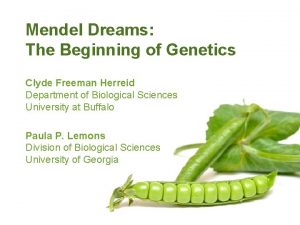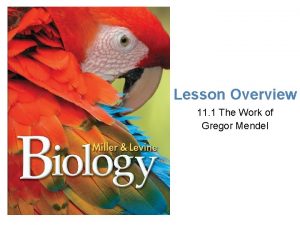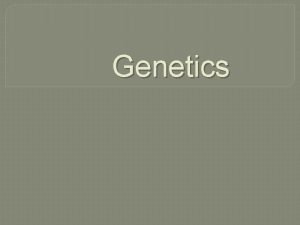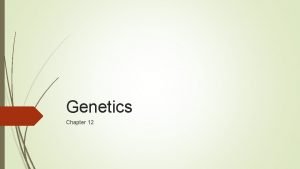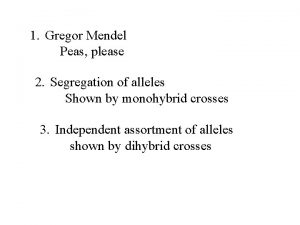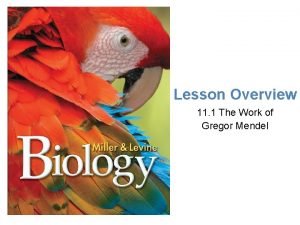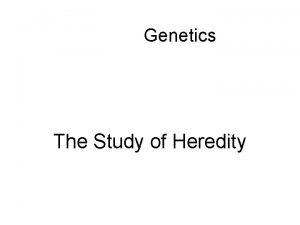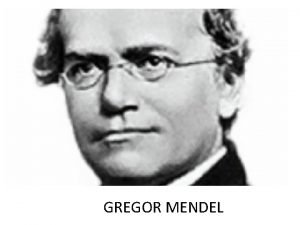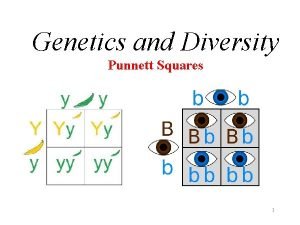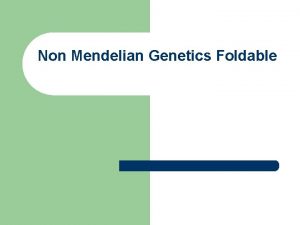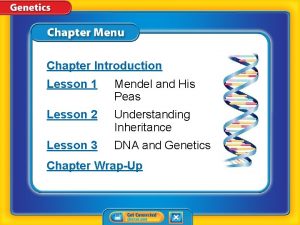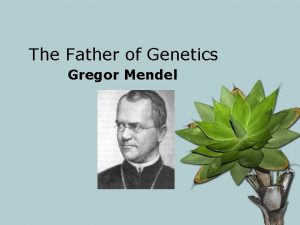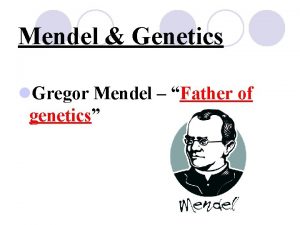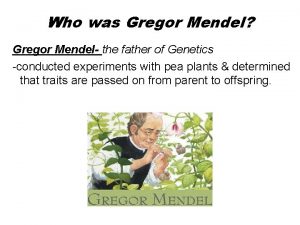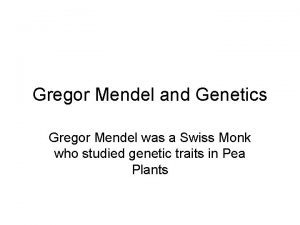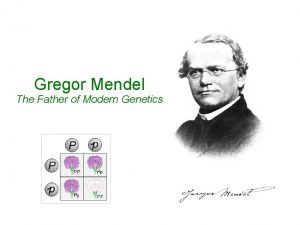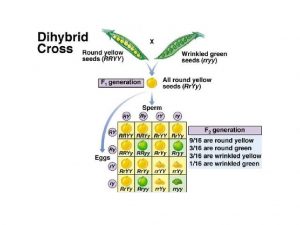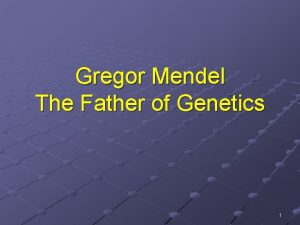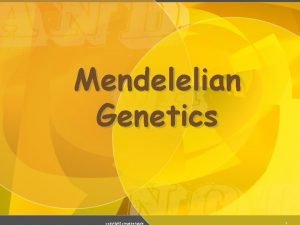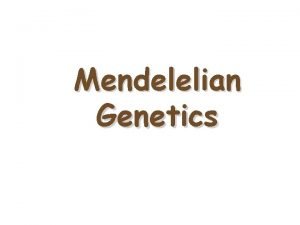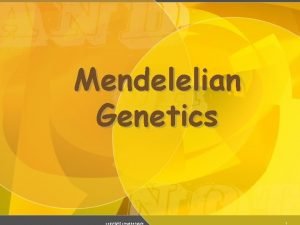MENDELELIAN GENETICS 1 Gregor Mendel father of Genetics
















































- Slides: 48

MENDELELIAN GENETICS 1

Gregor Mendel “father of Genetics” Responsible for the Laws governing Inheritance of Traits 2

Gregor Johann Mendel §Austrian monk §Studied the inheritance of traits in pea plants §He found that the plants' offspring retained traits passed from parental generation 3

Genetic Terminology §Trait - any characteristic that can be passed from parent to offspring §Heredity - passing of traits from parent to offspring §Genetics - study of heredity 4

Types of Genetic Crosses §Monohybrid cross - cross involving a single trait e. g. flower color §Dihybrid cross - cross involving two traits e. g. flower color & plant height 5

Punnett Square Used to help solve genetics problems 6

Genetic Terminology §Alleles - two forms of a gene (dominant & recessive) §Dominant - stronger of two genes expressed in the hybrid; represented by a capital letter (R) §Recessive - gene that shows up less often in a cross; represented by a lowercase letter (r) 7

More Terminology §Genotype - gene combination for a trait (e. g. RR, Rr, rr) §Phenotype - the physical feature resulting from a genotype (e. g. round, wrinkle) 8

Genotype & Phenotype in Peas 9

Genotype & Phenotype in Peas Genotype of alleles: R = Round seeds r = Wrinkled seeds All genes occur in pairs, so 2 alleles affect a characteristic Possible combinations are: Genotypes RR Rr rr Phenotypes ROUND WRINKLED 10

Genotypes §Homozygous genotype - gene combination involving 2 dominant or 2 recessive genes (e. g. RR or rr); also called pure §Heterozygous genotype - gene combination of one dominant & one recessive allele (e. g. Rr); also called hybrid 11

Law of Dominance In a cross of parents that are pure for contrasting traits, only one form of the trait will appear in the next generation. All the offspring will be heterozygous and express only the dominant trait. RR x rr yields all Rr (round seeds) 12

Law of Dominance 13

Mendel’s Pea Plant Experiments 14

Why peas plants? §Can be grown in a small area §Produce lots of offspring §Produce pure plants when allowed to selfpollinate several generations §Can be artificially crosspollinated 15

Reproduction in Flowering Plants • Pollen contains sperm • Produced by the stamen • Ovary contains eggs • Found inside the flower Pollen carries sperm to the eggs for fertilization Self-fertilization can occur in the same flower Cross-fertilization can occur between flowers 16

Some Pea Plant Traits • Seed shape --- Round (R) or Wrinkled (r) • Seed Color ---- Yellow (Y) or Green (y) • Pod Shape --- Smooth (S) or wrinkled (s) • Plant Height --- Tall (T) or Short (t) • Flower color --- Purple (P) or white (p) 17

Generation “Gap” • Parental P 1 Generation = the parental generation in a breeding experiment. • F 1 generation = the first-generation offspring in a breeding experiment. • F 2 generation = the second-generation offspring in a breeding experiment. 18

Monohybrid Crosses 19

Monohybrid Cross • Trait: Plant Height • Alleles: T– Tall • Cross: Tall plants • TT x t – short x short plants tt T T t Tt Tt Genotype: Tt Phenotype: Phenotype tall Genotypic Ratio: All alike Phenotypic Ratio: All alike 20

Monohybrid Cross • Trait: Plant Height • Alleles: T– Tall • Cross: Tall plants • Tt x T T t TT Tt t – short x tall plants Tt tt Genotypic Ratio: 1 TT: 2 Tt: 1 tt Phenotypic Ratio: 3 tall: 1 short 21

Practice Your Crosses • Refer to page 179 • Provide the genotypic AND phenotypic ratios • 1. Cross a homozygous green seed with a heterozygous yellow seed • 2. Cross a heterozygous round plant with a heterozygous round plant • 3. Cross a homozygous purple seed with a homozygous white seed 22

Review of Monohybrid Crosses • Phenotype is based on Genotype • Each trait is based on two genes, one from the mother and the other from the father • True-breeding individuals are homozygous, which means both alleles are the same. 23

MENDEL’S LAWS 24

Law of Segregation • During the formation of gametes (eggs or sperm), the two alleles responsible for a trait separate from each other. • Alleles for a trait are then "recombined" at fertilization, producing the genotype for the traits of the offspring. 25

Applying the Law of Segregation 26

Law of Independent Assortment • Alleles for different traits are distributed to sex cells (& offspring) independently of one another. 27

Summary of Mendel’s laws LAW SUMMARY Law of Dominance A dominant allele completely masks the effects of a recessive allele. Law of Segregation Alleles are separated into individual gametes to transmit genetic information to offspring. Law of Independent Assortment Alleles on different chromosomes are distributed randomly to individual gametes. 28

Exceptions To Mendel’s Original Principles • Incomplete • Environmental dominance effects on gene • Co-dominance expression • Multiple alleles • Linkage • Polygenic traits • Sex linkage 29

Incomplete Dominance and Codominance 30

Incomplete Dominance • Neither allele is dominant • Heterozygotes have an intermediate phenotype • Example: Japanese “Four o’clock” flower • red (RR) x white (rr) RR = red flower rr = white flower r r R R 31

Incomplete Dominance Cross: red (RR) x white (rr) r r R Rr Rr All Rr = pink (heterozygous pink) 32

Incomplete Dominance Checking your understanding… Show a cross between 2 pink 4 o’clock flowers. Give the genotypic and phenotypic ratios. 33

Codominance • Neither allele is dominant and both alleles are expressed in heterozygous individuals. • Example: blood type 34

Codominance Problem • Example: Homozygous male Type B (IBIB) • x Heterozygous female Type A (IAi) IA i IB I AI B I Bi 50% = IAIB 50% = IBi 35

Another Codominance Problem • Checking your understanding… • Example: male Type O (ii) x female type AB (IAIB) IA IB i I Ai I Bi 50% = IAi 50% = IBi 36

Codominance • Critical Thinking Question: If a boy has a blood type O and his sister has blood type AB, what are the genotypes and phenotypes of their parents? • boy - type O (ii) X girl - type AB (IAIB) 37

Codominance • Answer: IA IB i i I AI B ii Parents: genotypes = IAi and IBi phenotypes = A and B 38

Sex-linked Traits • Traits (genes) located on the sex chromosomes • Sex chromosomes are X and Y • XX genotype for females • XY genotype for males • Many sex-linked traits carried on X chromosome • Examples: color blindness, hemophilia 39

Sex-linked Trait Problem • Example: Eye color in fruit flies • (red-eyed male) x (white-eyed female) XRY x X r. Xr • Remember: the Y chromosome in males does not carry traits. • RR = red eyed r r X X • Rr = red eyed • rr = white eyed • XY = male XR • XX = female Y 40

Sex-linked Trait Solution: Xr XR XR Xr Y Xr XR Xr Xr Y 50% red eyed female 50% white eyed male 41

Female Carriers 42

Genetic Practice Problems 43

Practice • tall (TT) x dwarf (tt) pea plants t t T T 44

Solution: Round (RR) vs. wrinkle (rr) pea plants R R r r Rr Rr All Rr= ROUND (heterozygous round) 45

practice • tall (Tt) vs. tall (Tt) pea plants T t 46

Solution: tall (Tt) x tall (Tt) pea plants T t T TT Tt tt 1/4 (25%) = TT 1/2 (50%) = Tt 1/4 (25%) = tt 1: 2: 1 genotype 3: 1 phenotype 47

48
 Pp x pp
Pp x pp Gregor mendel’s principles of genetics apply to
Gregor mendel’s principles of genetics apply to How did gregor mendel contribute to genetics
How did gregor mendel contribute to genetics Austrian monk
Austrian monk Genes alelos
Genes alelos Chapter 12 lesson 1 the work of gregor mendel
Chapter 12 lesson 1 the work of gregor mendel Gregor mendel
Gregor mendel Gregor mendel laws
Gregor mendel laws Mendel data
Mendel data Cruza dihibrida
Cruza dihibrida How many pairs of chromosomes do humans have? *
How many pairs of chromosomes do humans have? * Gregor mendel
Gregor mendel Austrian monk gregor mendel
Austrian monk gregor mendel Who is gregor mendel
Who is gregor mendel Gregor mendel
Gregor mendel Gregor mendel
Gregor mendel Tesztelő keresztezés
Tesztelő keresztezés Suit separate
Suit separate Hardy weinberg equation
Hardy weinberg equation Who is gregor mendel and what did he do?
Who is gregor mendel and what did he do? Chapter 11 the work of gregor mendel
Chapter 11 the work of gregor mendel Fr gregor mendel
Fr gregor mendel Conclusion de gregor mendel
Conclusion de gregor mendel Gregor mendel video
Gregor mendel video Rryy x rryy
Rryy x rryy Gregor mendel summary
Gregor mendel summary Gregor johann mendel
Gregor johann mendel Gregor mendel 1865
Gregor mendel 1865 What did gregor mendel research
What did gregor mendel research Gregor mendel austrian monk
Gregor mendel austrian monk Gregor mendel referat
Gregor mendel referat Who is gregor mendel and what is he famous for
Who is gregor mendel and what is he famous for 11-2 probability and punnett squares answer key
11-2 probability and punnett squares answer key Mendels theory
Mendels theory The work of gregor mendel lesson 1 chapter 12
The work of gregor mendel lesson 1 chapter 12 Blood types
Blood types Gregor mendel chart
Gregor mendel chart Gregor mendel laws
Gregor mendel laws Gregor johann mendel steckbrief
Gregor johann mendel steckbrief Gregor mendel
Gregor mendel Y chromosome traits
Y chromosome traits Gregor mendel
Gregor mendel Gregor mendel
Gregor mendel Section 11-1 the work of gregor mendel
Section 11-1 the work of gregor mendel Gregor mendels work
Gregor mendels work In the punnett square shown in figure 11-1
In the punnett square shown in figure 11-1 Punnet square
Punnet square Mendel's genetics foldable
Mendel's genetics foldable Chapter 5 genetics lesson 1 mendel and his peas
Chapter 5 genetics lesson 1 mendel and his peas


